1920s - Hats For The New Woman
- Meaghan Armstrong
- Jan 28
- 8 min read
Updated: Feb 24

The significant social transformation following WWI was mirrored in the fashion of the new woman. 1920s millinery fashion and flapper hat trends demonstrated the modern woman.

There were new fabrics, new shapes, new hair, make-up and accessories. There were new and expanding ways to shop, and more and more women in the workforce had more disposable income. Fashion moved away from just the courtiers of Paris and, with the help of fashion houses creating clothing models that were intended to be copied by department stores, onto the bodies of the average working women.

The new, more simplistic shapes of clothing used less fabric and far fewer specialized and advanced sewing techniques, which made these fashions more attainable.

Hats, especially, were easier to make for the same reasons as the clothing, for the home sewist or local dress shop. Highly specialized millinery skills required of the previous century fell away in favour of minimal decorations and simplified shape and construction.. This became more obvious as the decade progressed.
At the start of the decade, a lot was happening in millinery and fashion, but today's interpretation of the era seems to have largely forgotten these developments.

The pastiche of exotic elements seen during the previous decade driven by Poiret's avant-garde designs was re-imagined in a more practical format - embellishment. Commonly called "oriental", details from Chinese and Russian folk embroidery to African and South American motifs, beading and tassels.
The term 'oriental' was a catch-all phrase born out of colonialism, not meaning Asian inspired but included all non-western, non-white designs and decorations. Folk embroidery from cultures of Europe, the Middle East, western Asia, and Eastern Europe were also classified under Orientalism.

In 1921, Russian immigrant designers fleeing the aftermath of the revolution came to Paris and began designing their own styles, influencing the Parisian designers with classic folk wear Russian hat shapes.



These influences are also visible in the popular clothing motifs of the time.
As for the hats, Kokoshnik headdresses and pyramidal hats grew into one of the key millinery styles of the 1920s.


Movies, for the first time, had an enormous and immediate influence on fashion. The 1921 French movie "Les Tois Muskateers" threw the tricorn and cavalier hats into the spotlight.


Straw and velvet versions of these hats were quickly on the heads of leading ladies of fashion, and the bicorn, another military-inspired shape, may have surpassed the cavalier and tricorn over the decade to establish itself as an important and iconic shape of the 1920s millinery.


This version of the bicorn, unlike previous iterations of it, was most often made with the sharply folded brim at the front and a slightly less folded brim at the back. It usually sported a one sided bow, a long dangling feather, jewel, tassel or ribbon.
These decorations feminized the design and also artistically moved them away from a pure military copy to something new.
The overall crown shape in the first 5 years was a slightly squared, rounded-tipped crown and a full but smallish brim measuring 5 to 7 cm, often turned up all around. These hats had a folded-up brim in a bucket-hat-type shape. As you can see below, the size of the brims varied tremendously, and a new kind of self-expression was becoming more socially acceptable with the array of models to choose from.

In 1922, the Panama hat was still quite popular for summer but was now often made with toyo, a kind of paper straw. The shape was still familiar with its pinches and bashes, but new plain sailor styles as well as deep crowned, wider brimmed boaters were widely available.

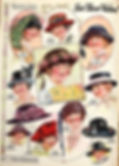
The cylinder-shaped crown arrived in 1923, and they sported tiny brims folded up at the front or slightly off center-front to be over one eye.



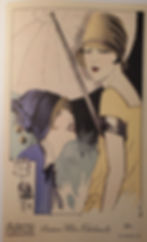
Decorations for all hats were made from folded bands of fabric, ribbons in smooth clean lines, appliques of wool felt or a single fabric flower. These types of decorations were common for all hats in all seasons.





In comparison to later in the decade, these earlier decorations were more exuberant but very subdued if compared to the previous decade.
In the summers of the early decade, fashions were long, tea-length gowns with a loose, straight fit, belted tightly and bloused out at the hip.

Summer hats were low on the head, like all hats in this decade, with wide oval brims that had either a very fat shape or slightly curved down. Smaller brimmed hats were, again, folded up at the front or over one eye.



Decorations on the hats in summer generally had more abundant silk ribbons in softer draping and clusters of flowers. This appears to continue in summer hats throughout the decade unless the hat was an Art Deco design.
It's difficult to miss discussing an iconic hat of the 1920s. One we still see today, the beret. The beret, as a hat design, has roots over 3000 years old, and in the previous 100 years to the 1920s, the beret took form mainly as the tam-o-shanter. The tam (o-shanter) continued its oversized mode of previous decades and was made in several panels or as a large circle of fabric with a crown. The Edwardians had determined that the tam was for sports and children, and in the 20s, young girls and teens were the people wearing it.



Often decorated with beading, feathers, brooches or braids, tams elevated the millinery wardrobe of the young by giving them the power to create their own hats.
Home knitting had become far more popular as a pastime, and with the influence of more easily and cheaply available magazines, yarn shops, yarn manufacturing companies and newspapers, the access to patterns to make your own tam held the imagination of young girls tightly.

Knitting a tam was a quick and inexpensive way to have new accessories, and making one for every outfit was achievable. Any young woman with knitting, crochet or sewing skills could participate.
Returning to the beret, in the early part of the decade, the beret was more like the tam-o-shanter as it was larger and floppy. These were made of felted wool or cut and sew fabrics. Sporty models have a narrow leather trim at the head size band or bottom of the crown.

Later in the decade the beret turned into the model we still can buy today. The selection of fabrics was larger than what is commercially available today but the shape of the classic French beret with the rolled head size hem and the stem or le cabillou in the center of the tip. These berets in the 20s were worn pulled down over the ears and to the brow. A style that would return in the late 1970s and early 1980s.

The Toque was still available in the 1920s and still favoured by mature women. The construction of the hats had changed from the large and complicated wireframe of the Edwardian era to stiffened fabric with minimal wire for support. Mature women tended to wear toques straight on the head. (Think dowager Lady Grantham from Downton Abbey - also excellent models of Edwardian to late teens fashion for the mature woman)

The trending set, also known as Flappers, started wearing toques over the ears and to the eyebrows. These toques were decadently adorned with sequins, beads and metallic embroidery. They were theatrical and dramatic fashion statements.

Flappers, and Hollywood also loved turbans. This is the only hat style worn on all occasions, informally, day or evening. They were an alternative to the cloche hats and flattered the new shorter hairstyle.


Sometimes, women simply wrapped lengths of cloth horizontally around the head leaving the crown of the head and hair exposed.
Turbans originated in ancient Assyria around 2500 BCE, and the previously discussed 'Orientalism' loved the versatility of such a hat.



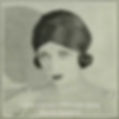


Milliners could cover a buckram form permanently with any glamorous fabric and adorn it with anything from jewels, feathers, beads and even strings of pearls.
The turban was a strangely democratic hat since it could be a simple scarf wrapped around the head in a "turban" like way or an expensive milliner-made, jewel-encrusted masterpiece. Of course turbans can be seen throughout time as fashion millinery but Paul Poiret was using them extensively in the teens. His influence on 1920s fashion can be directly linked.
The embellishments on hats during the 1920s can be considered experimental in certain aspects. Numerous hats feature Art Deco geometric patterns, individual flowers, oversized drooping flowers, or feathers on one side that alter the brim.

Additionally, beading, sequins, brooches, and other elements contribute significantly to the complexity of 1920s millinery.

The cloche stands as the pinnacle of hat design and is arguably the most influential hat of the 20th century. It could be said that the cloche is the last time a single millinery design has had such a significant impact up to the present day.

Many people, a century later, think that this was the only hat anyone wore during that time. So much so that many costume designers and production teams get 1920s millinery very wrong. However, the cloche was important and, by 1925, had firmly put itself center stage.
The cloche is partially attributed to Caroline Rebouxin, who debuted it in 1914 in Paris, but it took several years for it to really 'happen'. The cloche also did not have a monolithic design. It evolved for the duration of the decade, and through the century as it has been revisited.

In 1924, the brim was about 5 cm at most and often curled up, worn like a visor over the eyes. The brim could curve up or down or both in one hat and sometimes was split or sometimes layered over the ears and/or over the nape.
Many newspaper and magazine articles commented on how these hats blocked the wearer's periphery vision, and it is true that it was often obstructed.

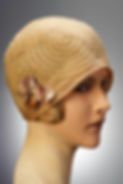
As the decade progressed, the 'bell' or cloche became a helmet rather than a cylinder or domed shape. Brims were almost or entirely non-existent or folded tightly against the crown. The 'helmet' shape also evolved into the casque shape usually created with cut and sew techniques with panels and was tightly fit. These casques were an option to the wool felt or straw helmet shapes.
These hat styles were lovely open spaces for creativity in decorations. Either with sparse Art Deco appliques, or elaborate flat ribbon work, embroidery, fans of bows or small clusters of flowers or feathers. The key decoration element is that everything is flat on the hat.
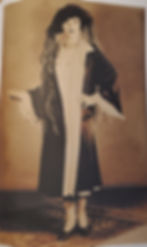
These hats changed the skill and trade of millinery forever. Prior to the 1920s, the popular millinery relied heavily on tremendous skill and hand labour. Edwardian hats - although a talented home seamstress could create something - were nearly fully dependent on master milliners to create the wire forms, which were then covered with buckram or esparterie and mull (a soft felt-like material to smooth the wireframe) before the fashion fabric. Strip-sewn straw also depended on the tremendous skill of millinery workers on specialized sewing machines.
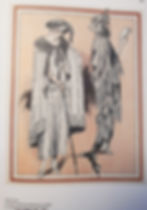
The cloche, casque, new toque, bicorn, turban, tam-o-shanter, and beret reduced the demand for these skilled workers, predominantly women, in the workforce. Although many millinery shops and milliners were still around, their expertise suddenly became less essential as the hats were simply not that complex.

The 1920s absolutely marked the beginning of the end of millinery trade unions, their master, journeyman, and apprentice structure, and their prevalence in the manufacturing world.

Not only had the new clothing fashions, short hairstyles, educational opportunities, and careers changed with and for the new woman and her new life. An entire women-filled industry declined. It truly was a new age.

